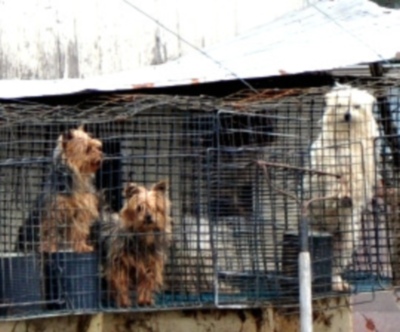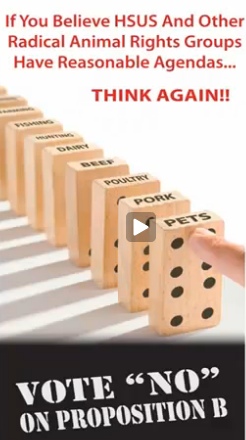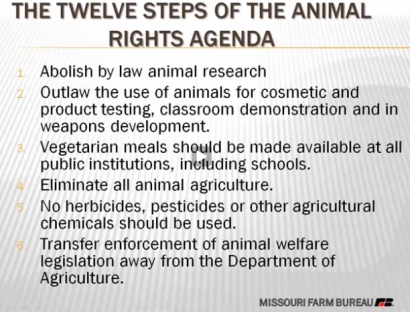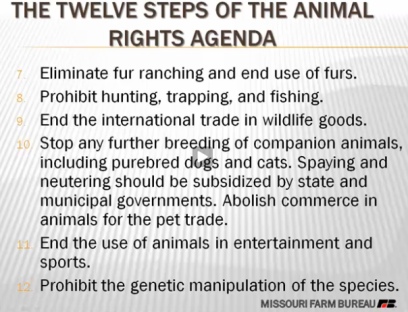Want to defeat an animal protection law? Tea Party might help

United States Department of Agriculture (USDA) found that in some of Missouri’s puppy mills–the ‘Dirty Dozen– violations included ‘sick or dying puppies who had not been treated by a veterinarian; dogs found shivering in temperatures as low as 9 degrees; and dogs so emaciated that their bones were visible through their skin.’ – The Humane Society of the United States (HSUS) / Photo: HSUS
By Katerina Lorenzatos Makris
If you’re trying to kill or modify a proposed animal welfare law—for example one that regulates high-volume commercial breeders or “puppy mills”—you might want to enlist the assistance of the Tea Party, according to the Missouri Farm Bureau (MFB).
“The Missouri Tea Party picked up that Prop B [the Puppy Mill Cruelty Prevention Act] was important,” said MFB’s director of marketing and commodities Kelly Smith, “and that they should be opposing it. They were a big help in doing that.”
Smith laid out a detailed strategy including other ways to fight animal welfare groups in his presentation “Protecting & Growing Agriculture Amidst the Activist Conflict – A Missouri Experience,” made to the Animal Agriculture Alliance “United We Eat” Summit in 2011.
As an example he focused on the case of Missouri’s Prop B, proposed by The Humane Society of the United States (HSUS) and other animal welfare groups to curb what they said was widespread neglect and abuse of the dogs used to breed hundreds of thousands of puppies in the state they condemn as the “puppy mill capital of America.”
Smith detailed the process by which his organization, dog breeders, and other animal farmers managed to get Prop B heavily altered—some say gutted. In 2010 voters approved the law, but under pressure from agriculture interests Gov. Jay Nixon later replaced it with a far less stringent version.
Animal Issues Reporter’s Katerina Lorenzatos Makris, who covered the AAA Summit, presents Smith’s version of the Prop B tale below in this installment of her multi-part series:
“Lessons learned in the ‘puppy mill capital of America’: The rise, fall and legacy of Missouri’s Prop B”
(For previous articles in this series, Parts 1 – 6, please see links below.)

‘Domino effect’ graphic was ‘very effective’ in convincing voters that animal activists planned to stop ‘poultry, meat, dairy, farming, hunting’ one by one, said Smith. / Photo: Missouri Farm Bureau and TruffleMedia
Speech by Kelly Smith, Missouri Farm Bureau (Part 7)
Lessons learned. What happened to us?
Whenever you hit these issues, you have to start early. You cannot procrastinate. You need to avoid distractions. We waited for that lawsuit, thinking that it’s common sense that a judge would throw it out and he didn’t. We didn’t get started on the campaign until August. We had September, October, and then the election in the first week of November.
You’ve got to have coalitions. You can’t do this by yourself. You have to encourage fundraising from the very beginning. Agriculture is not good at raising funds, but we just have to be out there and do that.
You have to identify the allies that you can use. And they may be people that you’re not used to, to be working with.
One of these… was the Tea Party in Missouri. For some reason, the Missouri Tea Party picked up that Prop B was important and they should be opposing it. They were a big help in doing that.
‘We had to influence the influencers’
You need to develop a standard presentation and make a distribution of that as well. I did over 180 presentations, and that’s actually traveling the state of Missouri giving talks for this thing. I just couldn’t hit everybody. Presentation’s about 50 minutes. I cut it down to 17, we video’d it, put it on a DVD, and we sent hundreds of those things out across our state. And people used them going to chamber meetings, Kiwanis Club meetings, women’s sororities.
We had to influence the influencers in a community to help them on our side. Have a standard presentation, put it on a DVD. A lot of people are willing to introduce a subject but not speak for that long.
You have to have good materials. One that we used that kind of became the foundation of all of our stuff is the domino effect here. It was very effective. You can see on top of the dominos….poultry, meat, dairy, farming, hunting. People have to understand [animal activists want to] take them out one at a time

‘There are twelve steps that the animal activists [use]… This is an attack, it’s a campaign,’ said Smith. / Photo: Missouri Farm Bureau and TruffleMedia
The other thing that was very, very effective, [was that] you have to connect the dots, and I have to give Karen Strange with the Missouri Federation of Animal Owners credit for this one.
There are twelve steps that the animal activists [use]. I’m not going to read those, but you can read them very quickly. [Points to a screen containing the information on the photographs, right.]
There are twelve steps. You have to tie the dots together to show people that this is a plan. This is an attack, it’s a campaign. They have to see all these things that are going on and that are working so that they understand this.
What I like about this, when I get to number ten, read number ten. “Stop any further breeding of companion animals including purebred dogs and cats. Spaying and neutering should be subsidized by state and municipal governments. Abolish commerce in animals for the pet trade.”

‘You have to tie the dots together to show people that this is a plan,’ said Smith. / Photo: Missouri Farm Bureau and TruffleMedia
Number ten was exactly what Proposition B was about in Missouri. So if you tell them that, and then boom, here’s the punch line… I think I forgot to put that slide in.
Anyways, these twelve items came from a book that was published in 1987. So for a quarter of a century these things have been around and the animal activist people have been doing them. We just haven’t been paying attention. They have to understand and you have to connect the dots for them.
HSUS is a ‘factory fundraising machine’
Always have to look for opportunities to educate urban citizens. If urban areas are factors as they are in Missouri, Kansas City and St. Louis, you need to have a full-time campaign person just to work in urban areas that agriculture does not understand how to work in. That’s where the Alliance for Truth came in.
You need to be tracking the opposition’s campaign funding and sharing that with the public. You have to brand them as out of state. The other thing that we like to do [is that because] they like to talk about factory farming, we like to talk about HSUS as a “factory fundraising machine.” That’s exactly what they are.
Using social media and youth volunteers
Social media is great. Look for opportunities for free media, radio shows, and also for creative, cheap advertising. Cable TV, website banners, and so forth are very effective with some of these things.
What we also found out is our youth in our state are a big resource and asset for us on this issue. Our collegiate farm bureau chapters, FFA [Future Farmers of America] chapters across the state, 4H Clubs got very involved and very active with this.
‘Animal activists are sore losers’
Other legislative proposals in our state deal with the ballot initiative process, and probably the one that has the biggest chance of happening is increasing the number of required signatures, the number of congressional districts to do that. We also have a constitutional amendment that would reserve the rights of people to raise animals in our state.
So what’s our next battle? HSUS and animal activists are sore losers. So far we’ve stayed one step ahead of them since the general assembly came back in January, but now they are proposing another ballot initiative called the Voter Protection Act.
The Voter Protection Act would not…if our legislators wanted to change something the people voted on, it would take 70 percent in our House and the Senate, which would be very difficult to get. And guess who the people pushing this, the Voter Protection Alliance. You recognize the first two of the names there. Now they’re trying to get more credibility by adding these other groups in there.
And with that, thank you very much.
Coming up soon in this series:
- Is Missouri’s Operation Bark Alert really working? 5,500 dogs seized from puppy mills, but what about those who aren’t?
More AIR on this topic:
Part 1: Missouri breeds 30% of puppies sold in U.S. pet stores, says farm bureau
Part 2: More than 5,500 dogs raided from Missouri dog breeders since start of ‘Operation Bark Alert’
Part 3: Law would have required better care for dogs than for children, says farm bureau)
Part 5: ‘Mutts’ comic strip characters helped pass a law to regulate dog breeders
Part 6: Lobbyists to ‘pay the price’ for helping animal welfare groups in Missouri
Puppy mills make dogs ‘autistic,’ says study
Reporter asks USDA to review study on damaged mental health of puppy mill dogs
Katerina Lorenzatos Makris is a career journalist, author, and editor. Credits include hundreds of articles for regional wire services and for outlets such as National Geographic Traveler, The San Francisco Chronicle, Travelers’ Tales, NBC’s Petside.com, and Examiner.com (Animal Policy Examiner), a teleplay for CBS-TV, a short story for The Bark magazine, and 17 novels for Avon, E.P. Dutton, Simon and Schuster, and other major publishers.
Together with coauthor Shelley Frost, Katerina wrote a step-by-step guide for hands-on, in-the-trenches dog rescue, Your Adopted Dog: Everything You Need to Know About Rescuing and Caring for a Best Friend in Need (The Lyons Press).
“HSUS and animal activists are sore losers.” Unfortunately, the only real losers in this battle are the animals…
I have a huge long post on this saved, and if I ever get to stop working this week (not lleiky), I’ll put it up. I’m so sick of hearing about Vick I wish he’d just crawl in a hole and die. I don’t want him to have a dog, but I’m starting to recognize this as a personal vendetta because I’m so disgusted with what he did. Vick had normal, family dogs in addition to his fighting dogs. He can have a pet, a companion, and not brutalize her. Logically, I recognize this, but I find myself not caring too much. We know very little about what other dog fighters did and didn’t do with their dogs. For all we know, other modern-day dog fighters who have been allowed to retain their dogs did similar horrific things. I don’t know how to feel about this. We also let other animal abusers go back to working with/around the animals they abused. But no one seems to care except in this case. It’s all very confusing.